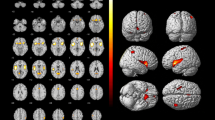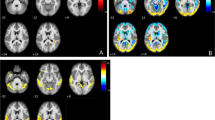Abstract
Objectives
To validate the value of whole-brain computed tomography perfusion (CTP) and CT angiography (CTA) in the diagnosis of mild cognitive impairment (MCI) and Alzheimerʼs disease (AD).
Methods
Whole-brain CTP and four-dimensional CT angiography (4D-CTA) images were acquired in 30 MCI, 35 mild AD patients, 35 moderate AD patients, 30 severe AD patients and 50 normal controls (NC). Cerebral blood flow (CBF), cerebral blood volume (CBV), mean transit time (MTT), time to peak (TTP), and correlation between CTP and 4D-CTA were analysed.
Results
Elevated CBF in the left frontal and temporal cortex was found in MCI compared with the NC group. However, TTP was increased in the left hippocampus in mild AD patients compared with NC. In moderate and severe AD patients, hypoperfusion was found in multiple brain areas compared with NC. Finally, we found that the extent of arterial stenosis was negatively correlated with CBF in partial cerebral cortex and hippocampus, and positively correlated with TTP in these areas of AD and MCI patients.
Conclusions
Our findings suggest that whole-brain CTP and 4D-CTA could serve as a diagnostic modality in distinguishing MCI and AD, and predicting conversion from MCI based on TTP of left hippocampus.
Key Points
• Whole-brain perfusion using the full 160-mm width of 320 detector rows
• Provide clinical experience of 320-row CT in cerebrovascular disorders of Alzheimerʼs disease
• Initial combined 4D CTA-CTP data analysed perfusion and correlated with CT angiography
• Whole-brain CTP and 4D-CTA have high value for monitoring MCI to AD progression
• TTP in the left hippocampus may predict the transition from MCI to AD





Similar content being viewed by others
References
Selkoe DJ (2012) Preventing Alzheimerʼs disease. Science 337:1488–1492
Beier MT (2007) Treatment strategies for the behavioral symptoms of Alzheimer's disease: Focus on early pharmacologic intervention. Pharmacotherapy 273:399–411
Alzheimer’s Association (2015) 2015 Alzheimer's disease facts and figures. Alzheimers Dement 11:332–384
Love S, Miners S, Palmer J et al (2009) Insights into the pathogenesis and pathogenicity of cerebral amyloid angiopathy. Front Biosci (Landmark Ed) 14:4778–4792
Revesz T, Ghiso J, Lashley T et al (2003) Cerebral amyloid angiopathies: a pathologic, biochemical, and genetic view. J Neuropathol Exp Neurol 62:885–898
Holtzman DM, Morris JC, Goate AM (2011) Alzheimer’s disease: the challenge of the second century. Sci Transl Med 3:77
Jack CR, Knopman DS, Jagust WJ et al (2010) Hypothetical model of dynamic biomarkers of the Alzheimer’s pathological cascade. Lancet Neurol 91:119–128
Weissleder R, Mahmood U (2001) Molecular imaging. Radiology 2192:316–333
Sluimer JD, van der Flier WM, Karas GB et al (2009) Accelerating regional atrophy rates in the progression from normal aging to Alzheimer’s disease. Eur Radiol 1912:2826–2833
Tapiola T, Pennanen C, Tapiola M et al (2006) MRI of hippocampus and entorhinal cortex in mild cognitive impairment: a follow-up study. Neurobiol Aging 291:31–38
van de Pol LA, van Der Flier WM, Korf ES et al (2007) Baseline predictors of rates of hippocampal atrophy in mild cognitive impairment. Neurology 6915:1491–1497
Apostolova LG, Hwang KS, Medina LD et al (2011) Cortical and hippocampal atrophy in patients with autosomal dominant familial Alzheimerʼs disease. Dement Geriatr Cogn Disord 232:118–125
Ben Ahmed O, Mizotin M, Benois-Pineau J et al (2015) Alzheimerʼs disease diagnosis on structural MR images using circular harmonic functions descriptors on hippocampus and posterior cingulate cortex. Comput Med Imaging Graph 44:13–25
Bohnen NI, Djang DS, Herholz K et al (2012) Effectiveness and safety of 18F-FDG PET in the evaluation of dementia: a review of the recent literature. J Nucl Med 531:59–71
Filippi M, Agosta F, Barkhof F et al (2012) EFNS task force: the use of neuroimaging in the diagnosis of dementia. Eur J Neurol 19:e131–e140, 1487-1501
Hoeffner EG, Case I, Jain R et al (2004) Cerebral perfusion CT: technique and clinical applications. Radiology 2313:632–644
Zimny A, Sasiadek M, Leszek J et al (2007) Does perfusion CT enable differentiating Alzheimerʼs disease from vascular dementia and mixed dementia? A preliminary report. J Neurol Sci 257:114–120
Rther J, Jonetz-Mentzel L, Fiala A et al (2000) Hemodynamic assessment of acute stroke using dynamic single-slice computed tomographic perfusion imaging. Arch Neurol 57:1161–1166
McKhann GM, Knopman DS, Chertkow H et al (2011) The diagnosis of dementia due to Alzheimer’s disease: recommendations from the National Institute on Aging-Alzheimer’s Association workgroups on diagnostic guidelines for Alzheimer’s disease. Alzheimers Dement 7:263–269
Petersen RC, Stevens JC, Ganguli M et al (2001) Practice parameter: early detection of dementia: mild cognitive impairment an evidence-based review. Report of the Quality Standards Subcommittee of the American Academy of Neurology. Neurology 569:1133–1142
Petersen RC (2004) Mild cognitive impairment as a diagnostic entity. J Intern Med 2563:183–194
Perneczky R, Wagenpfeil S, Komossa K et al (2006) mapping scores onto stages: mini-mental state examination and clinical dementia rating. Am J Geriatr Psychiatry 142:139–144
Wang Z, Ling P, Jia X et al (2012) The baseline and longitudinal changes of PCC connectivity in mild cognitive impairment: a combined structure and resting-state fMRI study. PLoS One 7, e36838
Bai F, Xie C, Watson DR et al (2011) Aberrant hippocampal subregion networks associated with the classifications of aMCI subjects: a longitudinal resting-state study. PLoS One 6, e29288
Maldjian JA, Whitlow CT (2012) Whither the hippocampus? FDG-PET hippocampal hypometabolism in Alzheimer disease revisited. AJNR Am J Neuroradiol 3310:1975–1982
Ishii K, Soma T, Kono AK et al (2007) Comparison of regional brain volume and glucose metabolism between patients with mild dementia with Lewy bodies and those with mild Alzheimer’s disease. J Nucl Med 485:704–711
Mosconi L, Tsui WH, De Santi S et al (2005) Reduced hippocampal metabolism in MCI and AD: automated FDG-PET image analysis. Neurology 6411:1860–1867
Chen Y, Wolk DA, Reddin JS et al (2011) Voxel-level comparison of arterial spin-labeled perfusion MRI and FDG-PET in Alzheimer disease. Neurology 7722:1977–1985
Jueptner M, Weiller C (1995) Review: does measurement of regional cerebral blood flow reflect synaptic activity? Implications for PET and fMRI. Neuroimage 22:148–156
McDonald CR, McEvoy LK, Gharapetian L et al (2009) Regional rates of neocortical atropy from normal aging to early Alzheimer disease. Neurology 736:457–465
Bai F, Liao W, Watson DR et al (2011) Mapping the altered patterns of cerebellar resting-state function in longitudinal amnestic mild cognitive impairment patients. J Alzheimers Dis 231:87–99
Maillard P, Carmichael O, Fletcher E et al (2012) Coevolution of white matter hyperintensities and cognition in the elderly. Neurology 795:442–448
Steketee RM, Bron EE, Meijboom R et al (2016) Early-stage differentiation between presenile Alzheimerʼs disease and frontotemporal dementia using arterial spin labeling MRI. Eur Radiol 26:244–253
Yildirim T, Karakurum Göksel B, Demir Ş et al (2016) Evaluation of brain perfusion in Alzheimer disease with perfusion computed tomography and comparison to elderly patient without dementia. Turk J Med Sci 46:834–839
Tang Z, Chen F, Huang J et al (2013) Low-dose cerebral CT perfusion imaging (CTPI) of senile dementia: diagnostic performance. Arch Gerontol Geriatr 56(1):61–67
Snowdon DA, Greiner LH, Mortimer JA et al (1997) Brain infarction and the clinical expression of Alzheimer disease: the Nun Study. Gerontologist 27710:813–817
Sparks DL (1997) Coronary artery disease, hypertension, ApoE, and cholesterol: a link to Alzheimer’s disease? Ann N Y Acad Sci 826:128–146
Grammas P (2000) A damaged microcirculation contributes to neuronal cell death in Alzheimer’s disease. Neurobiol Aging 212:199–205
Winkler DT, Bondolfi L, Herzig MC et al (2001) Spontaneous hemorrhagic stroke in a mouse model of cerebral amyloid angiopathy. J Neurosci 215:1619–1627
Probst A, Langui D, Ulrich J (1991) Alzheimer’s disease: a description of the structural lesions. Brain Pathol 14:229–239
Beckmann N, Schuler A, Mueggler T et al (2003) Age-dependent cerebrovascular abnormalities and blood flow disturbances in APP23 mice modeling Alzheimer's disease. J Neurosci 2324:8453–8459
Greenberg SM, Gurol ME, Rosand J et al (2004) Amyloid angiopathy-related vascular cognitive impairment. Stroke 35:2616–2619
Petersen RC (2009) Early diagnosis of Alzheimer’s disease: is MCI too late? Curr Alzheimer Res 64:324–330
Acknowledgements
This work was supported by The Shanghai Municipal Science and Technology Commission medical guide project no.134119b2100, 16411969200; Shanghai Municipal Commission of Health and Family Planning project no. 201640035.
Author information
Authors and Affiliations
Corresponding author
Ethics declarations
Guarantor
The scientific guarantor of this publication is Zhang Wei. E-mail: zhangwei976@163.com.
Conflict of interest
The authors of this manuscript declare no relationships with any companies, whose products or services may be related to the subject matter of the article.
Funding
The authors of this manuscript declare no relationships with any companies, whose products or services may be related to the subject matter of the article.
Statistics and biometry
No complex statistical methods were necessary for this paper.
Informed consent
Written informed consent was obtained from all subjects (patients) in this study.
Ethical approval
Institutional review board approval was obtained.
Methodology
Case-control study, performed at one institution.
Additional information
Zhang Bo and Gu Guojun are considered as first authors.
Rights and permissions
About this article
Cite this article
Zhang, B., Gu, Gj., Jiang, H. et al. The value of whole-brain CT perfusion imaging and CT angiography using a 320-slice CT scanner in the diagnosis of MCI and AD patients. Eur Radiol 27, 4756–4766 (2017). https://doi.org/10.1007/s00330-017-4865-1
Received:
Revised:
Accepted:
Published:
Issue Date:
DOI: https://doi.org/10.1007/s00330-017-4865-1




